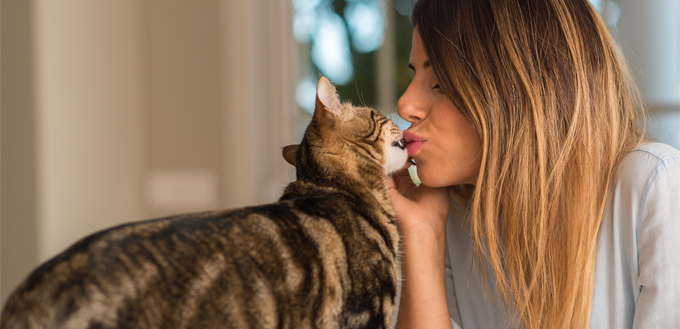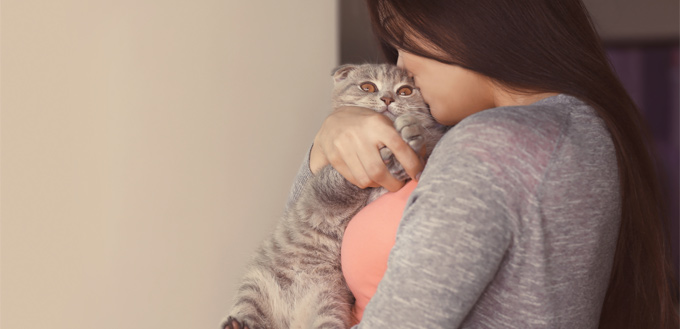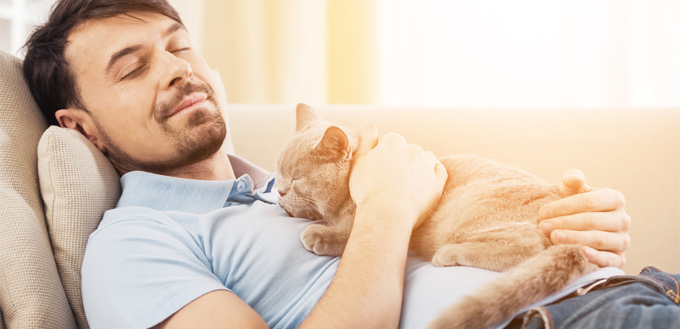You may love to give your cat kisses, but what does your cat think about it? There isn’t really a blanket yes/no answer to this. It really depends on the cat, and where you’re trying to kiss.
Before anything else, you need to be aware that kissing is very much a human way of showing affection. Most animals, including cats, can be very confused by this, and some really don’t understand what it is we’re trying to say to them.
Kisses on the Top of the Head
Some cats seem to like, or at the very least tolerate you kissing the top of their heads. If your cat purrs, rubs against you, or leans into you, then he probably likes the attention. If he puts his ears back, whacks his tail, or growls, then he’s not happy. He may even give you a swat of his paw to tell you to keep away from him.
Kisses on the Mouth
Many cats don’t like to be kissed on the mouth at all. They don’t like having our breath so close to their noses and mouths. As well as that, some cats find it to be simply too much of an invasion of their privacy. There can also be some risk of contracting a zoonotic disease from kissing your cat on the mouth, such as ringworm, bacteria, cat scratch fever, or parasites. Some people may be at greater risk than other, like pregnant women, people with compromised immune systems, and very young children.

How to Show Affection
Even if your cat doesn’t like to be kissed, you can still show him affection. Some people may say that cats are too independent to feel affection for their people, but recent research shows that this just isn’t true. Cats do feel affection for you, but their way of showing it is very different from ours. You’ll need to learn how to speak his language.
Slow Blink
Cats use a long, slow blink to tell others how they feel about them. It essentially says ‘I am so comfortable with you that I don’t mind being vulnerable’, or in more simple terms ‘I love you’. You can imitate this behavior with your cat, and he’ll probably understand what you’re trying to tell him.
Head Bunting
Head bunting is another method of feline affection. It’s not only about scent marking, it also shows feelings of trust. You can lower your head, and let your cat rub against you.
Full Body Rub
You may notice that your cat will rub himself against you from the tip of his nose to the end of his tail. When he does this, he’s scent marking you as part of his family. You should let him do this. You’re telling him that you’re open to this relationship between you, which will only strengthen your bond.
Take A Nap
Cats can show that they trust you by falling asleep while you’re there. This means that they believe that you will protect them from any potential dangers while they’re in a vulnerable position. You can reciprocate this. You don’t have to invite your cat into your bed if that’s not something you’d feel comfortable with, but you can take a short nap on your sofa with your cat. He will feel that you trust him enough to protect you while you’re sleeping, and will feel more deeply attached to you.
Belly Rubs
Some cats will show that they trust you, and are comfortable being vulnerable in your presence by rolling over and exposing their bellies. This doesn’t always mean that they want a belly rub. In fact, for some cats, that’s a step too far and will end up with him biting or scratching you. Although, other cats love nothing more than having a belly rub from their favorite human. Watch your cat for other signs of stress, and if he seems to be completely relaxed, then you may want to try gently stroking his tummy.
Training
Cats are actually very trainable. Indoor cats can actually really benefit from the mental stimulation that training can give them. In addition, it allows you to spend time with your cat, and really get to know him. Training should be reward based, so every time your cat completes a task successfully, you give him some of his favorite cat treats or some chicken. He will see you as a provider, which will help him feel more attached and connected to you.

How Your Cat Shows Affection to You
Cats will show you affection in their own way.
His Tail
A cat’s tail has many purposes, but it also acts as an emotional barometer. If you watch your cat’s tail, it will give you a pretty good idea of his emotional state. You should watch for signs like him wanting to touch you with his tail, whether this is winding it around your legs, or resting it on you as he sits beside you. Also watch out for him fluffing up the base of his tail, and quivering it. The rest of the tail will be upright, with a curve at the tip.
Vocalizing
When a female cat has kittens, she vocalizes to them with chirps, trills, meows, purrs, and chirrs. When the kittens are old enough, they will start to respond to her with their own vocalizations. Cats reserve these noises for other cats or people that they hold in particularly high esteem.

Grooming
Cats who live with other cats may engage in some mutual grooming – allogrooming. Sometimes, you can also notice your cat grooming you. This will usually happen if you are sitting stroking him, or if he is grooming himself beside you. It means that he feels that you belong to his family and he needs to keep you clean, and covered by his scent.
Presents
Your cat may give you presents, sometimes a dead mouse or bird. The proper response is to praise him and show him you appreciate it. Essentially, he’s treating you like you’re another cat in his family, albeit one who is a little bit useless at hunting!
You May Also Like: Why do Cats Bring Home Dead Animals?
Sources:
- Alia Hoyt, Is It OK to Kiss Your Pets on the Mouth?, HowStuffWorks
- Rebekah Kuschmider, How to Read Your Cat’s Body Language, WebMD
Note: The advice provided in this post is intended for informational purposes and does not constitute medical advice regarding pets. For an accurate diagnosis of your pet's condition, please make an appointment with your vet.







